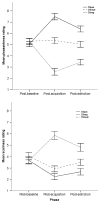How do social fears in adolescence develop? Fear conditioning shapes attention orienting to social threat cues
- PMID: 21895575
- PMCID: PMC3488275
- DOI: 10.1080/02699931.2010.524193
How do social fears in adolescence develop? Fear conditioning shapes attention orienting to social threat cues
Abstract
Social fears emerging in adolescence can have negative effects on emotional well-being. Yet the mechanisms by which these risks occur are unknown. One possibility is that associative learning results in fears to previously neutral social stimuli. Such conditioned responses may alter subsequent processing of social stimuli. We used a novel conditioning task to examine how associative processes influence social fear and attention orienting in adolescents. Neutral photographs were paired with socially rewarding or aversive stimuli during conditioning; a dot-probe task then assessed biases in attention orienting. The social conditioning task modified subjective ratings of the neutral stimuli. Moreover, for the neutral stimulus that was paired with the aversive stimulus, the strength of conditioning showed a relationship with subsequent attentional vigilance. The findings elucidate mechanisms by which negative peer experiences during adolescence may affect emotional processing.
Figures


Similar articles
-
Measuring the role of conditioning and stimulus generalisation in common fears and worries.Cogn Emot. 2013;27(5):914-22. doi: 10.1080/02699931.2012.747428. Epub 2012 Dec 10. Cogn Emot. 2013. PMID: 23216275
-
Direction of attention bias to threat relates to differences in fear acquisition and extinction in anxious children.Behav Res Ther. 2015 Jan;64:56-65. doi: 10.1016/j.brat.2014.11.010. Epub 2014 Dec 8. Behav Res Ther. 2015. PMID: 25540863
-
Impact of observational and direct learning on fear conditioning generalization in humans.Prog Neuropsychopharmacol Biol Psychiatry. 2023 Mar 8;121:110650. doi: 10.1016/j.pnpbp.2022.110650. Epub 2022 Sep 29. Prog Neuropsychopharmacol Biol Psychiatry. 2023. PMID: 36181957
-
Contributions of associative and non-associative learning to the dynamics of defensive ethograms.Elife. 2024 Dec 16;12:RP90414. doi: 10.7554/eLife.90414. Elife. 2024. PMID: 39680437 Free PMC article.
-
New perspectives on adolescent motivated behavior: attention and conditioning.Dev Cogn Neurosci. 2011 Oct;1(4):377-89. doi: 10.1016/j.dcn.2011.07.013. Dev Cogn Neurosci. 2011. PMID: 21977221 Free PMC article. Review.
Cited by
-
Fear conditioning and extinction across development: evidence from human studies and animal models.Biol Psychol. 2014 Jul;100:1-12. doi: 10.1016/j.biopsycho.2014.04.001. Epub 2014 Apr 16. Biol Psychol. 2014. PMID: 24746848 Free PMC article. Review.
-
Watch and Learn: Vicarious Threat Learning across Human Development.Brain Sci. 2021 Oct 13;11(10):1345. doi: 10.3390/brainsci11101345. Brain Sci. 2021. PMID: 34679409 Free PMC article. Review.
-
Functional connectivity between the nucleus accumbens and amygdala underlies avoidance learning during adolescence: Implications for developmental psychopathology.Dev Psychopathol. 2024 Sep 26:1-13. doi: 10.1017/S095457942400141X. Online ahead of print. Dev Psychopathol. 2024. PMID: 39324228
-
Easy to remember, difficult to forget: the development of fear regulation.Dev Cogn Neurosci. 2015 Feb;11:42-55. doi: 10.1016/j.dcn.2014.07.006. Epub 2014 Aug 4. Dev Cogn Neurosci. 2015. PMID: 25238998 Free PMC article.
-
Using a novel paradigm to examine observational fear-learning across development.Depress Anxiety. 2021 Mar 23:10.1002/da.23152. doi: 10.1002/da.23152. Online ahead of print. Depress Anxiety. 2021. PMID: 33755265 Free PMC article.
References
-
- Birmaher B, Brent DA, Chiappetta L, Bridge J, Monga S, Baugher M. Psychometric properties of the Screen for Child Anxiety Related Emotional Disorders (SCARED): A replication study. Journal of the American Academy of Child and Adolescent Psychiatry. 1999;38:1230–1236. - PubMed
-
- Davey GC. UCS revaluation and conditioning models of acquired fears. Behaviour Research and Therapy. 1989;27:521–528. - PubMed
-
- Esteves F, Parra C, Dimberg U, Öhman A. Nonconscious associative learning: Pavlo-vian conditioning of skin conductance responses to masked fear-relevant facial stimuli. Psychophysiology. 1994;31:375–385. - PubMed
-
- Hawker DS, Boulton MJ. Twenty years’ research on peer victimization and psychosocial maladjustment: A meta-analytic review of cross-sectional studies. Journal of Child Psychology and Psychiatry and Allied Disciplines. 2000;41:441–455. - PubMed
Publication types
MeSH terms
Grants and funding
LinkOut - more resources
Full Text Sources
Medical
